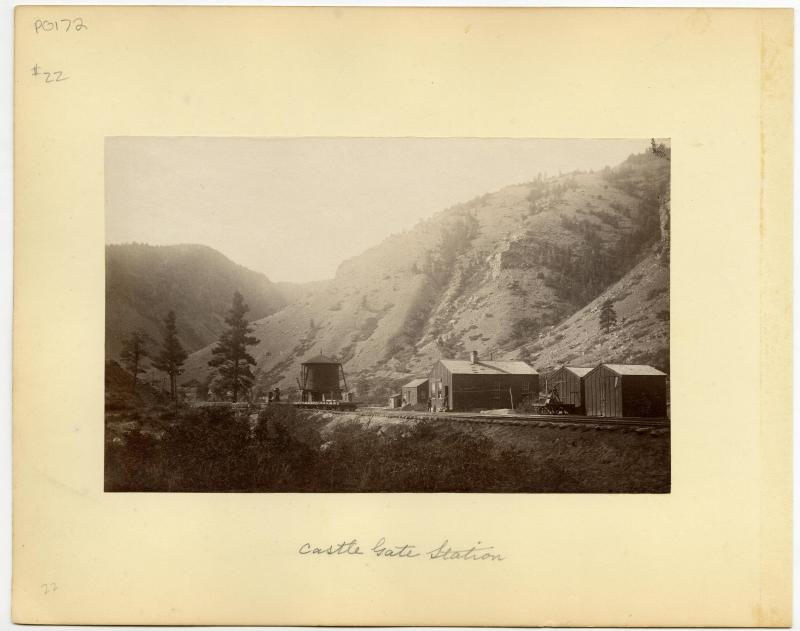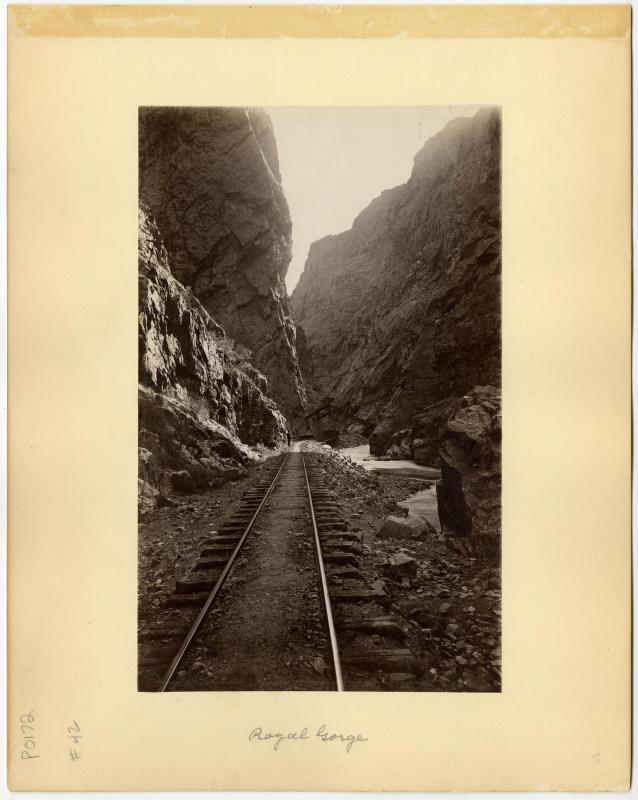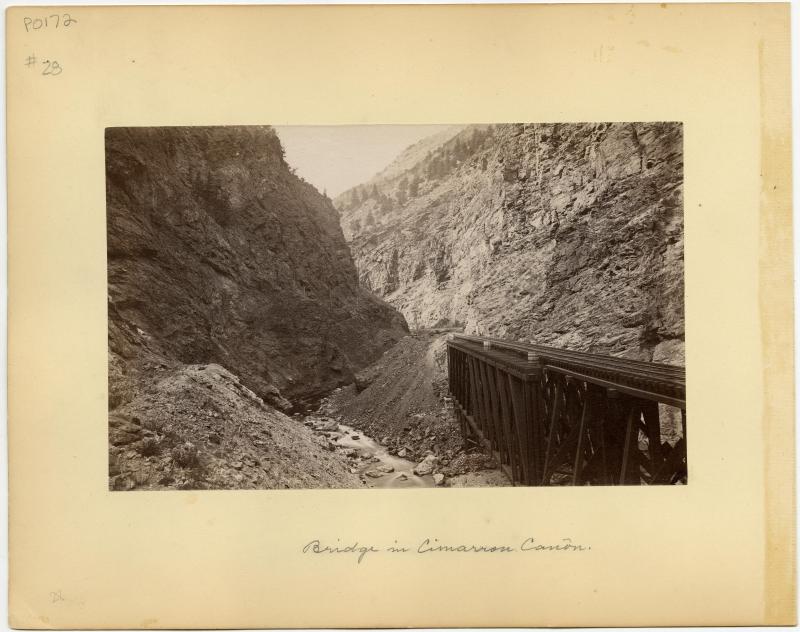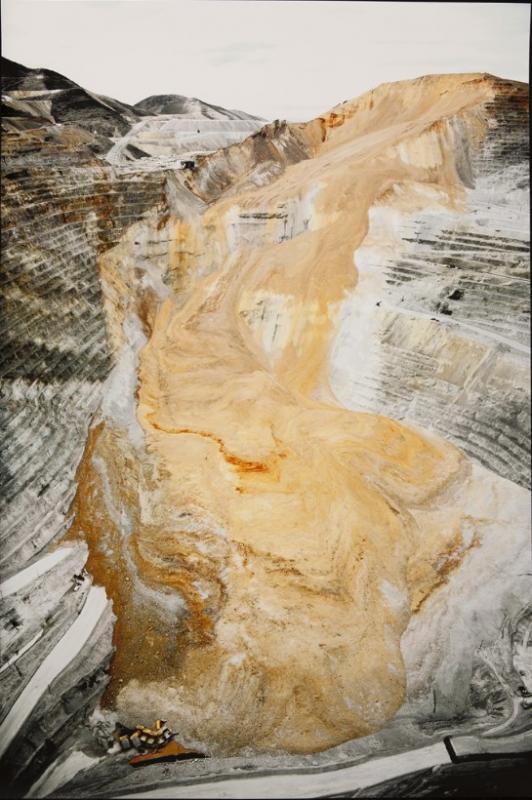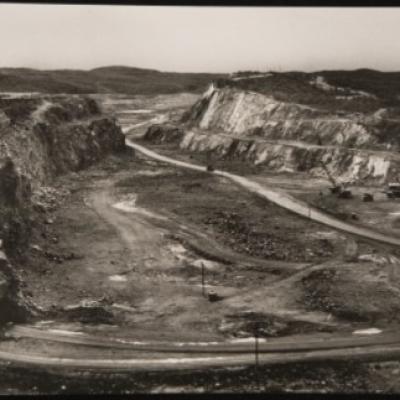Industry Economic Human Landscape
Visual Impacts
In Special Collections
At the Utah Museum of Fine Arts
Related Resources
In Special Collections
Similarly, Orland Lavell "Brig" Tapp's footage of Bingham Canyon Mine, shot from a tourist overlook, shows the paradoxical beauty and enchantment with the striped layers created by the excavation of the mine.
At the Utah Museum of Fine Arts
Center for Land Use Interpretation, Recent Landslide at Bingham Canyon Mine, 2013. UMFA2014.3.2.
The Center for Land Use Interpretation (CLUI), founded in 1994, is a research and education nonprofit that focuses on how land is legislated, used, owned, and represented. The organization supports scholarly and creative projects, maintains archives, and mounts analog and digital exhibitions. CLUI oversees regional facilities in Wendover (UT), the Mojave Desert, and Owens Lake (CA) in addition to its main office and exhibition space in Culver City.
Recent Landslide at Bingham Canyon Mine depicts the largest mining-induced landslide event in history. The event took place on April 10, 2013 at the mammoth mining operations just outside Salt Lake City. In less than an hour, 145 million tons of rock tumbled to the bottom of the pit, at times exceeding a speed of over one hundred miles per hour. Due to a sophisticated network of geotechnical monitoring equipment and observation systems, mining officials evacuated personnel, shut down operations, and even issued a press release in advance of the slide to report the inevitable. As a result, no injuries or fatalities occurred despite the landslide’s exceptional size and force.
Deeply Dependent, a print inspired by images of the Bingham Mine, was created using experimental and traditional printing techniques that explore, in material and process, the extraction of minerals and natural resources from the earth. (Marnie Powers-Torrey)
Pink Moon Atlas uses pigments gathered from industrial mining sites in letterpress prints and handbound books that are "emergent with observations from experience, divergent technologies, and multiplicities generated by Ochre on the page." (Elpitha Tsoutsounakis)
Innocence explores the relationship between resource extraction and art by examining connections between the Bingham Canyon Mine, The Guggenheim Museum of Art, and other marks on the landscape. (Lindsey Webb)
Toward a Bird's Eye View: Beyond mine, extracted visually engages with the Great Salt Lake through film. Often likened to a dead sea, Great Salt Lake is wildly alive and entangled with watersheds of the American West, supporting many lives, human and otherwise. Rozel Point invites paying closer attention to interrelationships—water and salt, art and tar, birds and beyond—that might help us perceive overlooked ecologies. (Gretchen Ernster Henderson)
Pit Stops: Open Pit Mine Overlooks in the West, an exhibition by the Center for Land Use Interpretation (CLUI), documents sites created for tourists to enjoy vistas of large open pit mines in Utah, New Mexico, and Arizona. (Organized by Aurora Tang)
Accidental Art (Warm Up)
Warm Up Exercise, 8th - 12th Grades
Sydney Porter Williams
A warm-up activity about intentional land art and prominent human-made features.
Ghosts and What is Left with Technology’s Progress
Lesson Plan, 6th Grade
Melissa Howell
Students will learn about mining in Utah- a brief local history and how the process works and has impacted our community in the past as well as now. Students will select two images of mines from the Mining the West collection and will make photocopies of the images and create photo-transfers. They will visually express what is lost in our communities due to mining and technology through utilizing a stippling technique inspired by Sandy Brunvand's ink trail style.
Mining the West: Before and After
Lesson Plan, 4th - 8th Grades
Kate Sherrill
During this lesson, we will explore how artists have used photography to document the impacts of mining and natural resource extraction on the American Southwest and the people who live there. Students will then create their own photographic collage to document changes to their environment by combining historic images with current drawings or photos of the student’s making.
Pushing the Bounds on Landscape and Mining
Lesson Plan, 8th - 12th Grades, Adaptable for Lower Levels
Janell Heck
In this lesson, students will be pushing the bounds when it comes to landscapes and how we view mining. Students will be referring to artist Patrick Nagatani and UMFA's "Mining in the West online show to create a new landscape altered by mining. This word "mining" can be taken in different situations whether it be literally or data mining. Information mining. This lesson is designed it push the bounds of the word mining. Students will be looking at Patrick as inspiration, he uses a collection of collage materials that have to do with mining aspects in different areas. Students will use these techniques when painting their landscapes.

